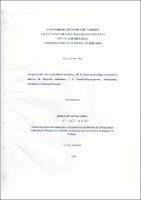| dc.description.abstract | Forty five (20 males and 25 females) specimens of Quiscalus mexicanus were
captured at Rio Chico. Escarrea and Chiriqui Viejo water shed in Chiriqui.
Panama, starting at January of 2009 to july of 2010 in order to determinate their
parasite population. A necropsy was carried out to all specimens identifying
Salmonella enterica at intestinal content of one out of 12 tested birds, another
bacterial species normally found at intestinal environment of birds were tbund
too. Parasites obtained includes Raillitina sp. (Cyclophyllidea), Mediorhynchus.
mattei Marchand y Vassiliades, 1982 (Giganthorhynchida, Giganthorhynchidae),
Isospora .sp. was found at 17.8 % (8/45) of analyzed specimens. Not identified
nematode were found at 58 %(26/45) between 0.0 and 4 by each analyzed bird.
Nine out of 45 individuals had cerebral cysts that were not identified for this
study. Mallophaga of family Melliponidae was Hound in allthe specimens. Spores
of , Alternaria sp. and Curvalaria were found at intestinal content samples but
culture procedures resulted positives only for development of Penicillium sp. and
some Mucorales, both fungus possibly relatives to human pathogens groups.
There was two characteristically different species of filarial at 20 % of blood
frotis (9/45). 21 % of individuals did not have any intestinal parasites. 23 % o
analyzed birds showed one species of intestinalparasites, 36 % of birds had up to
two species of intestinal parasites simultaneously and 19.5 % of birds had until
three species of different parasites simultaneously. Any of specimens of Q.
mexicanus showed signs indicating that the presence of these parasites anecting
its behavior or anatomophysiological features. Any identified groups looks to be
related to human pathology. | es_ES |
| dc.description.abstract | Se realizó la captura, disección, y exploración de cucarachas (Blattaria)
provenientes de las cuencas de los ríos Chiriquí Viejo, Escarrea, Chico y
Chiriquí, para identificación de los parásitos transportados por ellas hasta
hospedantes humanos, principalmente. y animales domésticos, y la recolección,
preparación, montaje, preservación y registro de diferentes especímenes como
una colección resumida de referencia inicial de las especies de cucarachas de la
región centro - occidental de la provincia de Chiriquí. Los insectos preservados
se entregaron al Museo de Peces de Agua Dulce e Invertebrados Acuáticos
(MUPADI) de la Universidad Autónoma de Chiriqui. Los parásitos conectados se
preservaron en el Centro de Investigaciones y Diversidad Micológica (CAMI) de la
UNACHI. De un total de 286 cucarachas, se capturaron 79.7 % Periplaneta
americana, 3.5 % P. australasiae, 0.7% aHo Blattella gemánica, 0.7 % Blaberus
discoidalis, 0.7 % B. craniifer, 2,8 % Hyporichnoda lithomorpha. 4,2 %
Panchlora nivea 4.2 %o Riatia fulgidaa. Se identificaron protozoarios Ciliophora
(Balantidium), oociistos de Coccidia (cystoisospora belli, Eimeria sp.),
Blastocystidae (Blastocystis), huevos de Nematoda (Trichuris trichiura, Ascaris
lumbricoides), Nemátoda (Thelastoma icemi , Euryconema sp.), un cystacanto de
un Acanthocephala no identificado,Strongyloides sterocalis , Enferobius
vemlicularis y un Pensastomida (Railietiella frenatus)
Tanto Thelastoma como Eyryconema son parásitos de insectos y otros
artrópodos y Railietiella es parásito de Geckonidae. Balantidium , Cystoisospora,
Ascaris y Trischuris son parásitos de humanos. | |

